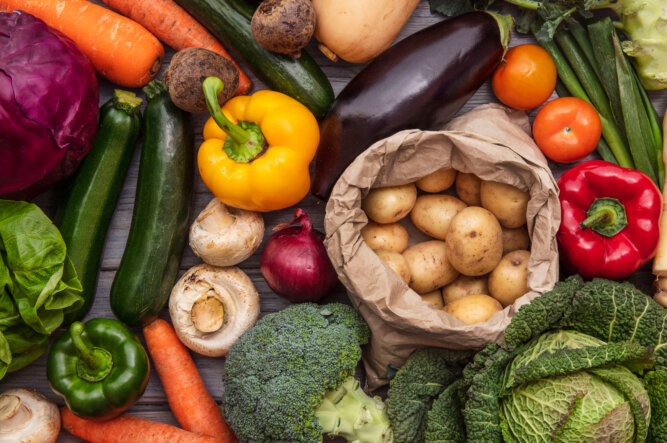US Harvest Season: Route Factors and Key Insights for Carriers

What are you waiting for?
Make more money starting now.
Harvest season has a big impact on the trucking and logistics industry. It can boost spot freight rates, strain reefer capacity, and lengthen shipping times for other sectors as carriers flock to harvest regions. And a high volume of trucks in concentrated areas also increases the risk of delays, which is important to consider when planning any loads during harvest season.
The “busy season” for harvests is regional, and specific to the produce and crop harvests in that area. Learn how best to plan your routes according to seasonal harvests and find loads during this high-demand period.
Factors impacting routes
Three major factors can impact routes: the region, the product, and seasonal construction.
Peak harvest season by region
Knowing which months will be busy in a region can help you understand which shipping routes will be the most active.
California Harvest Season
California’s diverse climate allows for year-round production of many crops, but specific seasons see higher yields for certain produce.
- Strawberries: Peak season runs from April through June, with significant production continuing into early summer. Key growing regions include Ventura County and the coastal areas of Santa Maria and Watsonville.
- Stone fruits: Peaches, plums, and nectarines peak from May to October. These fruits thrive in the Central Valley due to its warm summers and rich soils.
- Vegetables: Artichokes, asparagus, and leafy greens such as spinach and lettuce are primarily harvested from spring through early summer.
- Citrus fruits: Citrus, including oranges and mandarins, are available from November through June, with peak production varying by variety. The warmer southern regions like Riverside and Ventura counties are major producers.
Florida Harvest Season
Florida’s unique climate allows for multiple harvest seasons throughout the year.
- Strawberries: Florida strawberries reach their peak from December through March. This period sees the highest quality and volume, particularly from regions like Plant City.
- Oranges: Oranges are in season from mid-April to July due to longer daylight hours.
- Tomatoes: Tomato season runs from October through May, with the highest yields during the winter and spring months
- Sweet corn: The peak season for sweet corn is April through July. Florida’s warm climate allows for early harvests, providing fresh corn before other regions begin production.
- Blueberries: Florida blueberries are typically harvested from March to early May, offering early-season fruit before northern states begin their harvests.
Midwest Harvest Season
The Midwest, known for its fertile farmland, experiences distinct growing seasons that affect the availability of various produce throughout the year. Key produce items and their peak seasons include:
- Apples: Harvested from July through October, with peak season in late summer and early fall. Michigan is renowned for apple production.
- Corn: Corn harvest varies according to the state and type of corn; in Iowa and Kansas, it tends to be harvested from September to October, whereas in Michigan, it is a little later, between October and November.
- Tomatoes: Peak season runs from July through October. The hot summers provide ideal growing conditions for tomatoes, making them abundant during these months.
- Peppers: Both sweet and hot peppers peak from June through September. The diversity in pepper types, from bell peppers to hot jalapeños, makes them a versatile crop in the region.
- Berries: Strawberries, raspberries, and blueberries are primarily harvested in June and July.
- Root vegetables: Beets, carrots, and radishes have extended growing seasons from spring through fall, with peaks in early and late seasons.
- Leafy greens: Spinach, kale, and various lettuce types are available from May through October, thriving in spring and fall.
Pacific Northwest Harvest Season
The Pacific Northwest, including Washington, Oregon, and parts of British Columbia, has a diverse agricultural output, thanks to its unique climate.
- Apples: Peak season runs from August through November, and the Columbia Basin contributes significantly due to its ideal growing conditions.
- Berries: Blueberries, blackberries, and raspberries are harvested from June through September. The Willamette Valley is particularly noted for its high-quality berry production.
- Cherries: Harvested primarily in June and July, cherries are a major crop in the Pacific Northwest, especially in Washington.
- Pears: Pears are in season from August through November.
- Vegetables: Root vegetables such as carrots, potatoes, and parsnips are harvested from late summer through winter. Winter vegetables like broccoli, cauliflower, and kale are harvested later in the year, from June to February.
Peak harvest season by product
Here’s a breakdown of peak seasons for specific fruits and vegetables:
- Fresh fruits:
- Spring: Strawberries, rhubarb, apricots, and cherries mark the beginning of the fresh fruit season.
- Summer: A wide array of fruits, including blackberries, blueberries, raspberries, peaches, plums, and watermelons, reach their peak.
- Fall: Apples, pears, and pumpkins dominate the harvest season.
- Winter: Citrus fruits like oranges, mandarins, and grapefruit are at their best during these colder months.
- Vegetables:
- Spring: Asparagus, peas, artichokes, and radishes are among the first vegetables to be harvested.
- Summer: Tomatoes, cucumbers, corn, and various peppers thrive during the warm months.
- Fall: Root vegetables such as carrots, beets, and potatoes, as well as squash and pumpkins, are plentiful.
- Winter: Leafy greens like kale and spinach, along with winter squash and root vegetables, reach their peak.
Seasonal construction
The high demand for shipping at certain times of the year can create chaos on roadways.
For example, the I-4 at I-275 in Tampa, Florida, is known for frequent bottlenecks, and this area can be even more congested in April and May, when oranges, tomatoes, sweet corn, and blueberries are en route to their next destination.
In Los Angeles — where heavy traffic is the norm — the convergence of SR 60 and SR 57 can be stop-and-go in April and June, because of the harvest of strawberries, stone fruits, vegetables, and citrus fruits.
How to plan routes
Planning routes around harvest times isn’t too different than normal route planning, but it may take a little extra time.
- Use a route planner: A route planner specifically for truckers lets you choose preferred lanes when planning your routes, avoid traffic bottlenecks, and see an accurate ETA for your delivery.
- Keep an eye on weather conditions: Use a weather app to avoid driving in dangerous conditions and set up severe weather alerts.
- Make time for fuel stops, rest, and maintenance: Build time into your routes for fuel stops at locations where you can also do maintenance checks. And allow yourself time for adequate rest.
Finding loads
To make the most during harvest season, plan your loads well in advance.
- Load boards: Load boards like Truckstop’s allow drivers to search for loads based on their specific requirements and can notify them of new matches that fit their criteria. These boards update in real time, providing access to a wide range of freight opportunities nationwide.
- Freight brokers: Working with freight brokers can simplify finding loads. Brokers act as intermediaries between shippers and carriers, negotiating rates and handling logistics. While they charge a commission, they can save time and help find consistent work.
- Dispatch services: Dispatch services offer comprehensive support, including finding loads, managing paperwork, and providing back-office support. They charge fees similar to freight brokers but can be especially helpful for owner-operators looking to streamline their operations.
- Networking and relationships: Building strong relationships with shippers, brokers, and other drivers can lead to more opportunities. Networking through industry events, social media, and professional associations can help drivers stay informed about available loads and market conditions.
Plan your loads around harvest season with Truckstop
Being up to date on harvest season can help you capitalize on the surge of shipping demand. The challenge can be finding loads that work for your schedule, which is why using the Truckstop Load Board can help.
The Truckstop Load Board lets you search by state and equipment type so you can plan your work during harvest season — or anytime. The Truckstop Load Board also provides broker information like credit ratings and pay history, so you can be confident you’re working with the best. Get your free load board demo now to see how it can work for you!
Get helpful content delivered to your inbox.
Sign up today.
Find high-quality loads fast, get higher rates on every haul, and access tools that make your job easier at every turn.






